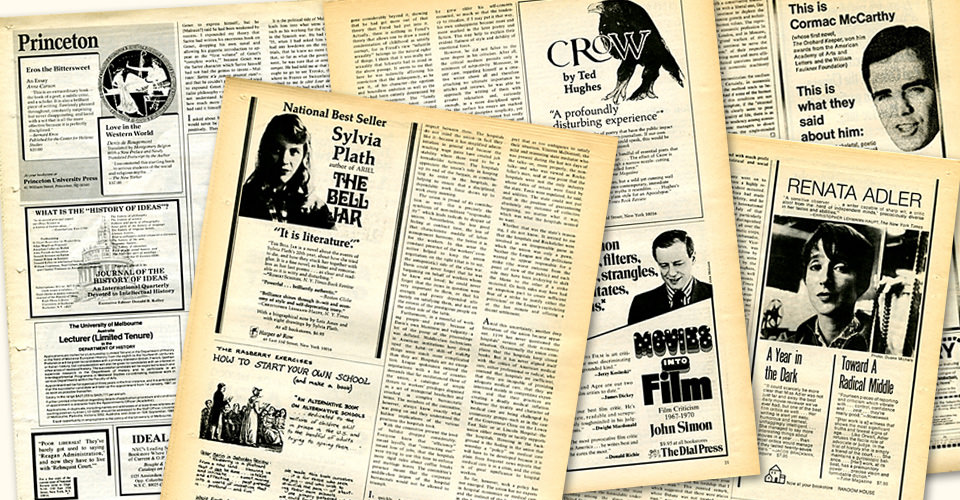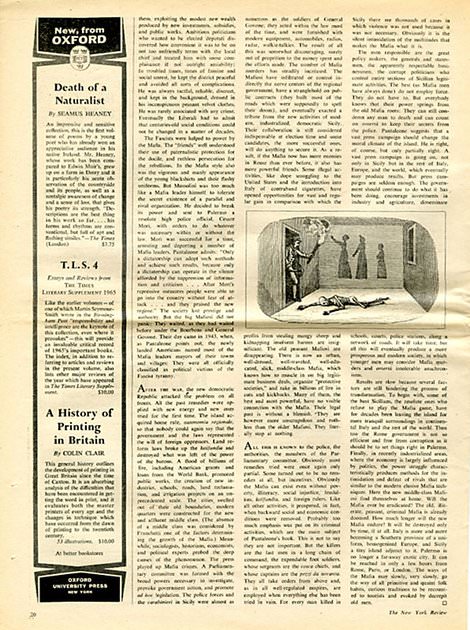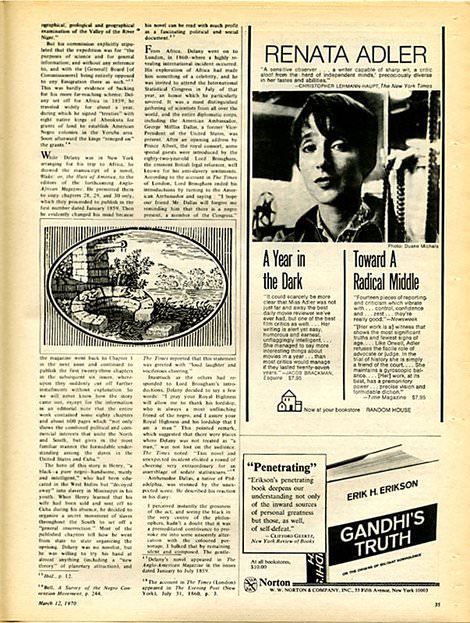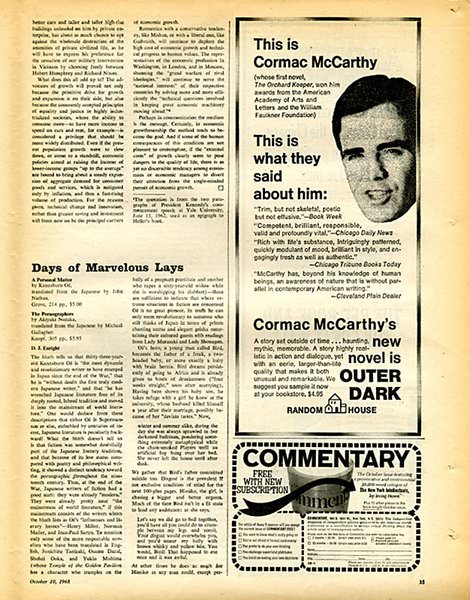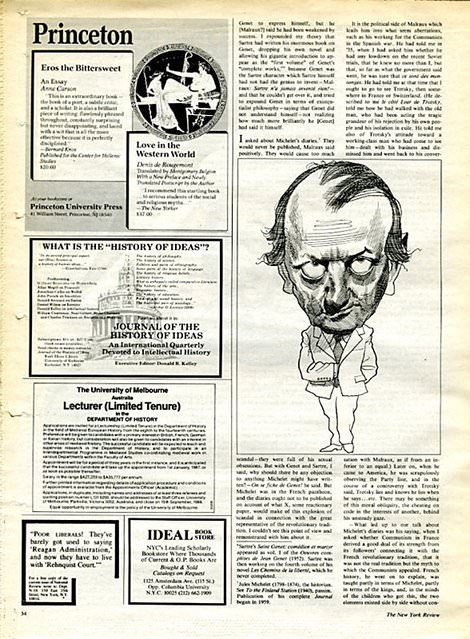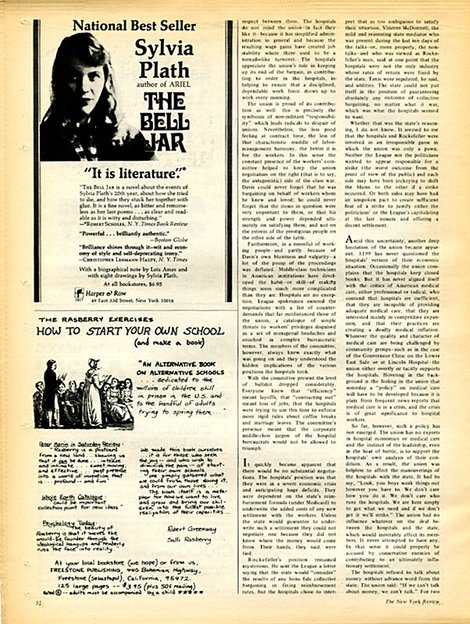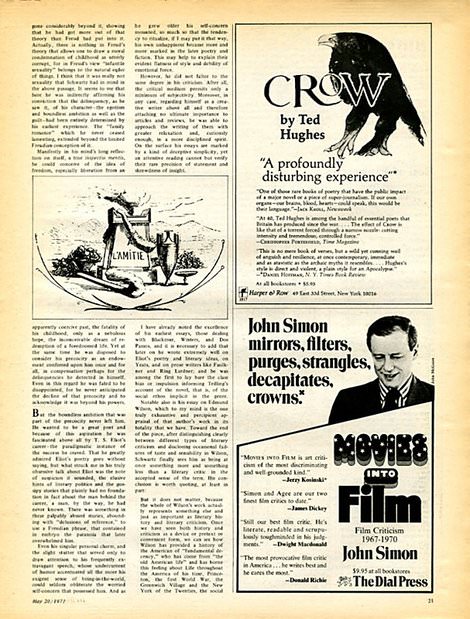Getting started can be difficult. When your name draws a blank, it’s unlikely that anyone will buy what you’re selling. Luckily, the attention that worthy unknowns need in order to get noticed has a price. And for fifty years, publishers with books to sell and authors with a name to make have announced their arrival with an appearance in The New York Review: though not, at least initially, under a byline.
In the Review’s twenty-ninth issue, dated October 22, 1964, the third of more than thirty books written by the historian Howard Zinn was advertised on page 13. Zinn was a professor at Boston University when Beacon Press published SNCC: The New Abolitionists in 1964, and not completely unknown: five years earlier, his doctoral dissertation on Fiorello LaGuardia had won a prestigious award from the American Historical Association. But Howard Zinn’s examination of the Student Non-Violent Coordinating Committee and their ‘revolutionary spirit’ (“whose implications,” the ad’s copy promises, “we have only begun to realize,”) drew the attention of general readers, sympathetic and otherwise. Four months after the book’s ad appeared and in the same pages, Laura Carper considered SNCC: The New Abolitionists in an omnibus review focused on race relations.
The poet Seamus Heaney has contributed, among other pieces, a memoriam of Robert Lowell and an article on Thomas Flanagan to the Review. And when Heaney’s acclaimed translation of Beowulf was published in 1999, a passage was excerpted in the NYRB with insightful critical and exegetic notes from the author. But the first time his name appeared, in a single-column ad that ran in the October 8, 1968 issue of the Review, Heaney, or more precisely his publisher, Oxford University Press, was a paying advertiser. “An impressive and sensitive collection, this is the first volume of poems by a young poet who has already won an appreciative audience in his native Ireland,” read the copy for his book Death of Naturalist. Almost thirty years later, the Nobel Prize committee would justify their selection of Heaney as laureate with less subdued praise for his “works of lyrical beauty and ethical depth, which exalt everyday miracles and the living past.”
The move Howard Zinn and Seamus Heaney made from the Review’s advertising margins to its editorial substance wasn’t unique. Renata Adler, Cormac McCarthy, and Anne Carson: before these names could dependably draw a crowd, marketers and copy-writers introduced them to readers of the Review.
A Year in the Dark (Random House) and Toward a Radical Middle (Random House), the first two books written by The New Yorker staffwriter, critic, journalist, and novelist Renata Adler, were advertised in the March 12, 1970 issue of the Review. Their titles appeared beneath a dramatic author photo (a novelty in a publication that, for several years, was almost exclusively illustrated by David Levine and Grandville.) Adler’s name would move onto a New York Review byline in 1980, when she published her famously critical review of the film critic Pauline Kael; and then in 2013, NYRB Classics returned Adler’s two novels, Speedboat and Pitch Dark, to print.
The novelist Cormac McCarthy is famously publicity averse. Nevertheless, in the October 8, 1968 issue of the Review, the camera-shy southwesterner, flush with the success of his first novel, swallowed his pride and lent his likeness to Random House’s advertisements for his second, Outer Dark. “I saw you blush!” Oprah would accuse McCarthy, years later, when he joined her book club to chat about his novel The Road. In 1968, the author does no such thing: he grins toothily, like a rockabilly star, his hair slicked up into a modest pompadour.
In 1987, the classicist Anne Carson, according to the American Academy of Poets, “burst onto the international poetry scene.” One year earlier, Princeton University Press advertised Carson’s book-length essay on love in literature, Eros the Bittersweet, in the pages of the Review. Bernard Knox, a long-standing contributor and classicist himself, reviewed Carson’s Autobiography of Red (Vintage) for the Review in 1998, and he recalled his early affection Eros the Bittersweet, felt so keenly that he was moved to recommend the author to her eventual publisher: “This is an extraordinary book,” he confided to the editors at Princeton University Press. “The book of a poet, a subtle critic, and a scholar… a brilliant piece of writing, flawlessly phrased throughout, constantly surprising but never disappointing…” Knox’s praise (a blurb such as publishers’ dreams are made of) appeared on the book’s jacket and in advertising copy, attracting so many readers that in 1999 Eros the Bittersweet, recently put back in print by Dalkey Archive Press, was named one of the 100 Best Works of Non-fiction by the Modern Library.
Not every love story can end so happily. When Elizabeth Hardwick reviewed Sylvia Plath’s novel The Bell Jar in the August 12, 1971 issue of the Review, Plath had been dead for eight years. For months previously, Harper & Row had run advertisements for The Bell Jar in the Review, featuring the author’s ominous portrait above an insistent claim: “It is literature.”
Advertisement
The advertisements for Plath’s book ran simultaneously with advertisements for Crow, a new book of poems by another Harper & Row author, her estranged husband Ted Hughes. Since Plath’s suicide, Hughes had overseen the successful publication of Ariel, a posthumous collection of her poetry that was read by many to intimate her discontent with married life and to foreshadow her death. “Her fate and her themes,” Elizabeth Hardwick wrote in her review of The Bell Jar, “are hardly separate and both are singularly terrible.” In the July 22, 1971 issue, a month before Hardwick’s review of Plath, Stephen Spender reviewed Crow, focusing on the role of the poet in a degenerate modern culture. Plath wasn’t mentioned.
If an author’s works are revered, adored, or simply read enough, then they seem to gradually become less stories to be read and more myths to be retold: biographies and works of criticism foregather over decades to revisit, consider, and explain. And perhaps the signal distinction of a book’s canonization is its magnificent, hardback reappearance in a deluxe edition, decked out in the new raiment befitting a cultural touchstone. In France, Bibliothèque de la Pléiade publishes durable, authoritative, and handsome editions of French classics. J. M. Dent does likewise for the English in England. But before 1979, when the nonprofit publisher The Library of America was founded with a grant from the Ford Foundation and the National Endowment of the Humanities, works of American literature could aspire to no commensurate apotheosis. The various works of Melville, Hawthorne, and Whitman occasionally dropped out of print, unattainable but for in “old college textbooks, some disintegrating paperbacks.” The United States was unique, Edmund Wilson complained, as “the only civilized country where one could not obtain the standard works of its great authors in convenient and reliable form.”
Spread over two pages in the May 13, 1982 issue of the Review, The Library of America announced the correction of this “great wrong.” For the first time, American literary history could be “read and reread” in “convenient, permanent, authoritative form.” Even lesser-known works—Melville’s Typee, Whitman’s Specimen Days—were scrupulously collected, expertly edited, and durably bound into “books you can proudly hand on to future generations.”


